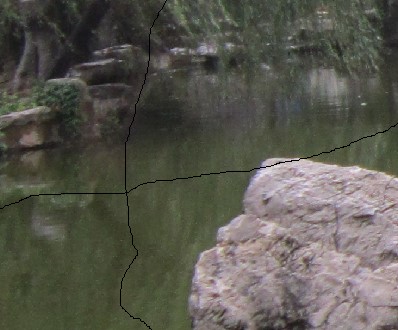hdu 5092 dp
来源:互联网 发布:vmware player mac 编辑:程序博客网 时间:2024/05/23 01:45
<span style="font-family: 'Times New Roman'; font-size: 12px; background-color: rgb(255, 255, 255);">Seam Carving</span>
Time Limit: 2000/1000 MS (Java/Others) Memory Limit: 65536/65536 K (Java/Others)Total Submission(s): 444 Accepted Submission(s): 196
Problem Description
Fish likes to take photo with his friends. Several days ago, he found that some pictures of him were damaged. The trouble is that there are some seams across the pictures. So he tried to repair these pictures. He scanned these pictures and stored them in his computer. He knew it is an effective way to carve the seams of the images He only knew that there is optical energy in every pixel. He learns the following principle of seam carving. Here seam carving refers to delete through horizontal or vertical line of pixels across the whole image to achieve image scaling effect. In order to maintain the characteristics of the image pixels to delete the importance of the image lines must be weakest. The importance of the pixel lines is determined in accordance with the type of scene images of different energy content. That is, the place with the more energy and the richer texture of the image should be retained. So the horizontal and vertical lines having the lowest energy are the object of inspection. By constantly deleting the low-energy line it can repair the image as the original scene.

For an original image G of m*n, where m and n are the row and column of the image respectively. Fish obtained the corresponding energy matrix A. He knew every time a seam with the lowest energy should be carved. That is, the line with the lowest sum of energy passing through the pixels along the line, which is a 8-connected path vertically or horizontally.
Here your task is to carve a pixel from the first row to the final row along the seam. We call such seam a vertical seam.

For an original image G of m*n, where m and n are the row and column of the image respectively. Fish obtained the corresponding energy matrix A. He knew every time a seam with the lowest energy should be carved. That is, the line with the lowest sum of energy passing through the pixels along the line, which is a 8-connected path vertically or horizontally.
Here your task is to carve a pixel from the first row to the final row along the seam. We call such seam a vertical seam.
Input
There several test cases. The first line of the input is an integer T, which is the number of test cases, 0<T<=30. Each case begins with two integers m, n, which are the row and column of the energy matrix of an image, (0<m,n<=100). Then on the next m line, there n integers.
Output
For each test case, print “Case #” on the first line, where # is the order number of the test case (starting with 1). Then print the column numbers of the energy matrix from the top to the bottom on the second line. If there are more than one such seams, just print the column number of the rightmost seam.
Sample Input
24 355 32 7517 69 7354 81 6347 5 456 651 57 49 65 50 7433 16 62 68 48 612 49 76 33 32 7823 68 62 37 69 3968 59 77 77 96 5931 88 63 79 32 34
Sample Output
Case 12 1 1 2Case 23 2 1 1 2 1
14年上海邀请赛的一道水水的dp,和经典的数塔模型几乎是一样的,直接从上往下d就可以了。唯一的两点不同:第一是在路径上所有数字的和相等的情况下,要选择最靠右的那条路,这个可以优先更新右边的点;第二是要输出路径,开一个pre路径,pre[i][j]表示点(i,j)的状态是从点(i-1,pre[i-1][pre[i][j]])继承过来的,详见代码
#include<algorithm>#include<iostream>#include<cstdio>#include<cstring>using namespace std;#define INF 100000000typedef long long LL;LL dp[500][500] , a[500][500] , pre[500][500] , ans[500];int main(){ LL n , m , T; scanf("%I64d", &T); LL Cas = 1; while(T--) { scanf("%I64d%I64d", &n, &m); for(LL i=1; i<=n; ++i) { for(LL j=1; j<=m; ++j) { scanf("%I64d", &a[i][j]); } } printf("Case %I64d\n", Cas); Cas++; memset(dp, 0, sizeof(dp)); for(LL i=1; i<=m; ++i) dp[0][i] = a[0][i]; for(LL i=0; i<=n; ++i) dp[i][0] = dp[i][m+1] = INF; for(LL i=1; i<=n; ++i) for(LL j=1; j<=m; ++j) { dp[i][j] = dp[i-1][j+1];///在选择三个点带来的效果相同的时候优先选择继承靠右的那个点 pre[i][j] = j+1; if(dp[i][j] > dp[i-1][j]) { dp[i][j] = dp[i-1][j]; pre[i][j] = j; } if(dp[i][j] > dp[i-1][j-1]) { dp[i][j] = dp[i-1][j-1]; pre[i][j] = j-1; } dp[i][j] += a[i][j]; } /** for(LL i=1; i<=n; ++i) { for(LL j=1; j<=m; ++j) { prLLf("%I64d ", dp[i][j]); } prLLf("\n"); }**/ LL Min = INF; LL t; for(LL j=m; j>=1; --j) ///从右往左找和最小的路径 { if(dp[n][j] < Min) { Min = dp[n][j]; t = j; } } ans[0] = t; LL k = 1; for(LL i=n; i>1; --i) ///从最后一个点顺着pre数组一直往前找,找到路径 { ans[k++] = pre[i][t]; t = pre[i][t]; } printf("%I64d", ans[n-1]); for(LL i=n-2; i>=0; --i) printf(" %I64d", ans[i]); printf("\n"); } return 0;}另外说一点,本题用记忆化搜索也特别好做,有兴趣的可以试试,直接往回回朔输出就好了。 0 0
- HDU 5092 DP
- hdu 5092 dp
- hdu 5092 dp
- 【DP】 HDU 5092 Seam Carving
- hdu 5092 Seam Carving(dp)
- HDU 5092 Seam Carving DP
- HDU DP
- DP? HDU
- DP? HDU
- DP? HDU
- 【dp】HDU
- 【dp】HDU
- 【dp】 HDU
- DP? HDU
- Hdu 5092 Seam Carving(dp)
- HDU 5092 Seam Carving(DP, 路径)
- HDU 5092 Seam Carving(DP)
- hdu 5092 Seam Carving dp+记录路径
- 正则表达式
- P1314 作业调度方案
- 开发工程师必看!不管你技术多牛逼
- numpy中一些函数的用法
- XCode6如何创建Category
- hdu 5092 dp
- cp: cannot create symbolic link to fat format of usb: Operation not permitted
- 二叉树的递归、层次与非递归遍历
- 137 朴英 松堂
- 关于cocos2dx空包的大小测试
- Javascript定义类(class)的三种方法
- 新手学js之——简单的带暂停计时器
- 我的java学习之路(1)jdk的安装与配置
- for循环中有多个限制结束条件的正确写法


